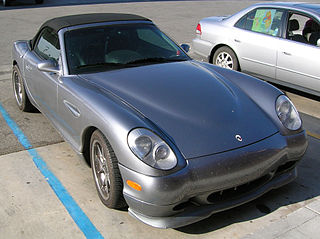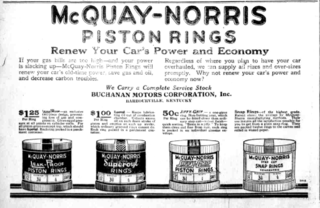
A hubcap or hub cap is a decorative disk on an automobile wheel that covers at minimum the central portion of the wheel, called the hub. An automobile hubcap is used to cover the wheel hub and the wheel fasteners to reduce the accumulation of dirt and moisture. It also has the function of decorating the car.

The Esperante is a sports car made by Panoz, an American car manufacturer.

The Ford Modular engine is Ford Motor Company's overhead camshaft (OHC) V8 and V10 gasoline-powered small block engine family. Introduced in 1990, the engine family received its “modular” designation by Ford for its new approach to the setup of tooling and casting stations in the Windsor and Romeo engine manufacturing plants.

The Chevrolet Vega is a subcompact automobile that was manufactured and marketed by GM's Chevrolet division from 1970 to 1977. Available in two-door hatchback, notchback, wagon, and sedan delivery body styles, all models were powered by an inline four-cylinder engine designed specifically for the Vega, with a lightweight, aluminum alloy cylinder block. The Vega first went on sale in Chevrolet dealerships on September 10, 1970. Variants included the Cosworth Vega, a short-lived limited-production performance model, introduced in the spring of 1975.

The ArmaLite AR-10 is a 7.62×51mm NATO battle rifle designed by Eugene Stoner in the late 1950s and manufactured by ArmaLite. When first introduced in 1956, the AR-10 used an innovative combination of a straight-line barrel/stock design with phenolic composite, a new patent-filed gas-operated bolt and carrier system and forged alloy parts resulting in a small arm significantly easier to control in automatic fire and over 1 lb (0.45 kg) lighter than other infantry rifles of the day. Over its production life, the original AR-10 was built in relatively small numbers, with fewer than 10,000 rifles assembled. However, the ArmaLite AR-10 would become the progenitor for a wide range of firearms.
Nikasil is a trademarked electrodeposited lipophilic nickel matrix silicon carbide coating for engine components, mainly piston engine cylinder liners.

The Toyota UZ engine family is a gasoline fueled 32-valve quad-camshaft V8 piston engine series used in Toyota's luxury offerings and sport utility vehicles. Three variants have been produced: the 1UZ-FE, 2UZ-FE, and 3UZ-FE. Production spanned 24 years, from 1989 to mid 2013, ending with the final production of the 3UZ-FE-powered Toyota Crown Majesta I-FOUR. Toyota's UZ engine family was replaced by the UR engine family.
A hypereutectic piston is an internal combustion engine piston cast using a hypereutectic aluminum alloy with silicon content greater than the eutectic point of 12 weight percent silicon. Most aluminum-silicon casting alloys are hypoeutectic, meaning the silicon content is lower than the eutectic point, and contain relatively fine elemental silicon crystals formed through the eutectic reaction during solidification. In addition to fine silicon crystals, hypereutectic alloys also contain large primary silicon crystals that form before the eutectic reaction. As a result it contains a much higher phase fraction of silicon. Consequently, hypereutectic aluminum has a lower coefficient of thermal expansion, which allows engine designers to specify much tighter tolerances. The silicon content of these alloys is typically 16-19 weight percent, and above this content the mechanical properties and castability degrade substantially. Special molds, casting, and cooling techniques are required to obtain uniformly dispersed primary silicon particles throughout the piston material.

The Chrysler Hemi engine, known by the trademark Hemi or HEMI, refers to a series of high-performance American overhead valve V8 engines built by Chrysler with hemispherical combustion chambers. Three generations have been produced: the FirePower series from 1951 to 1958; a famed 426 cu in (7.0 L) race and street engine from 1964-1971; and family of advanced Hemis (displacing between 5.7 L 6.4 L from 2003 to 2024.

The Vector W8 was a sports car produced by American automobile manufacturer Vector Aeromotive Corporation from 1989 to 1993. It was designed by company founder and chief designer Gerald Wiegert while receiving refinements by Vector's head of engineering David Kostka. The W8 was the production version of the Vector W2 prototype that the company demonstrated throughout the 1980s.

An air hammer, also known as an air chisel, is a pneumatic hand tool used to carve in stone, and to break or cut metal objects apart. It is designed to accept different tools depending on the required function.

The Smith & Wesson Models 908, 908s, 909, 910, and 915 are 9×19mm Parabellum, short-recoil-operated double-action/single action (DA/SA) semi-automatic pistols Value Series pistols. All of these pistols utilize a stainless barrel, an aluminum alloy frame, and either a carbon steel or stainless steel slide. The S&W Model 915 was produced from 1992 to 1994, while the S&W Model 910 was introduced in 1995 as a replacement for the Model 915 and was manufactured through 2006.

The Barrett REC7 is an American firearm manufactured as a selective-fire fully-automatic and semi-automatic rifle by Barrett Firearms. It is an M4 carbine utilizing a short-stroke gas piston system. REC7 is available in either 5.56×45mm NATO or 6.8mm Remington SPC. The REC7 is Barrett's second AR-pattern rifle chambered for the 6.8mm Remington SPC cartridge, the first being the Barrett M468 rifle. The 6.8 SPC-chambered M468 rifle employed the same direct gas-impingement system as the M4.

The ME Four-Twelve is an American high-performance concept car that was engineered, developed and produced by Chrysler in 2004. The name is a combination of the Mid-Engine with Four turbochargers on a Twelve cylinder engine.
Rheinmetall Automotive is the Automotive sector of the parent group Rheinmetall. The company emerged in 1997 through the merger of KS Kolbenschmidt GmbH, Neckarsulm, and Pierburg GmbH, Neuss. Hence, at its various traditional locations the company is commonly known as Kolbenschmidt or Pierburg. 40 production plants in Europe, the Americas, Japan, India and China employ a total workforce of around 11,000. Products are developed in cooperation with international auto manufacturers. Rheinmetall Automotive ranks among the 100 biggest auto industry suppliers worldwide and is an important partner to the industry for such products as exhaust gas recirculation systems, secondary-air systems, coolant pumps, and pistons for car gasoline engines and as well as for the commercial vehicle sector.
Semi-solid metal casting (SSM) is a near net shape variant of die casting. The process is used today with non-ferrous metals, such as aluminium, copper, and magnesium. It can work with higher temperature alloys that lack suitable die materials. The process combines the advantages of casting and forging.The process is named after the fluid property thixotropy, which is the phenomenon that allows this process to work. Thixotropic fluids flow when sheared, but thicken when standing. The potential for this type of process was first recognized in the early 1970s. Its three variants are thixocasting, rheocasting, and thixomolding. SIMA refers to a specialized process to prepare aluminum alloys for thixocasting using hot and cold working.

A running board or footboard is a narrow step fitted under the side doors of a tram, car, or truck. It aids entry, especially into high vehicles, and is typical of vintage trams and cars, which had much higher ground clearances than today's vehicles. It is also used as a fashion statement on vehicles that would not otherwise require it. The origin of the name running board is obscure; the first running boards predate automobiles and were installed on carriages as early as the 17th century.

McQuay-Norris was a maker of automobile engine parts such as piston rings, and chassis parts like steering wheel knuckle bolts. It also produced and distributed electrical controls for gas appliances. Based in St. Louis, Missouri, the company merged with Eaton Yale & Towne Inc., Cleveland, Ohio, in August 1969. Prior to the merger, the McCord Corporation, of Detroit, Michigan, acquired 10.5% of McQuay-Norris common stock, in June 1969.
UDMC PVAR rifles are Filipino variants of the Armalite AR-15 and AR-10, using the Pneumatic Valve and Rod system manufactured by United Defense Manufacturing Corporation.
An aluminum internal combustion engine is an internal combustion engine made mostly from aluminum metal alloys.













